Real Madrid travelled to the Estadio Giuseppe Meazza for Wednesday night’s bout against Serie A champions Internazionale.
Neutral fans’ mouths will have been watering in anticipation of two of European football’s biggest clubs locking horns in the opening round of the UEFA Champions League. The game was certainly not a classic but there were a number of entertaining moments throughout from both sides.
It took until stoppage time for Rodrygo to latch onto a lovely-weighted pass from new signing Eduardo Camavinga for the deadlock to be broken as Carlo Ancelotti’s side snagged all three points in the dying embers. Rodrygo has now scored 60 percent of his goals for the Spanish giants in the Champions League.
From a tactical perspective, the game was quite interesting as Simone Inzaghi’s men were defensively sound throughout. The Nerazzurri also looked good going forward and could have mustered up a win if it wasn’t for the heroics from Thibaut Courtois who earned himself the man of the match award.
This article will be a tactical analysis of the game between Inter and Real. It will be an analysis of the tactics applied by both head coaches and now Real managed to come out on top.
Formations and lineups
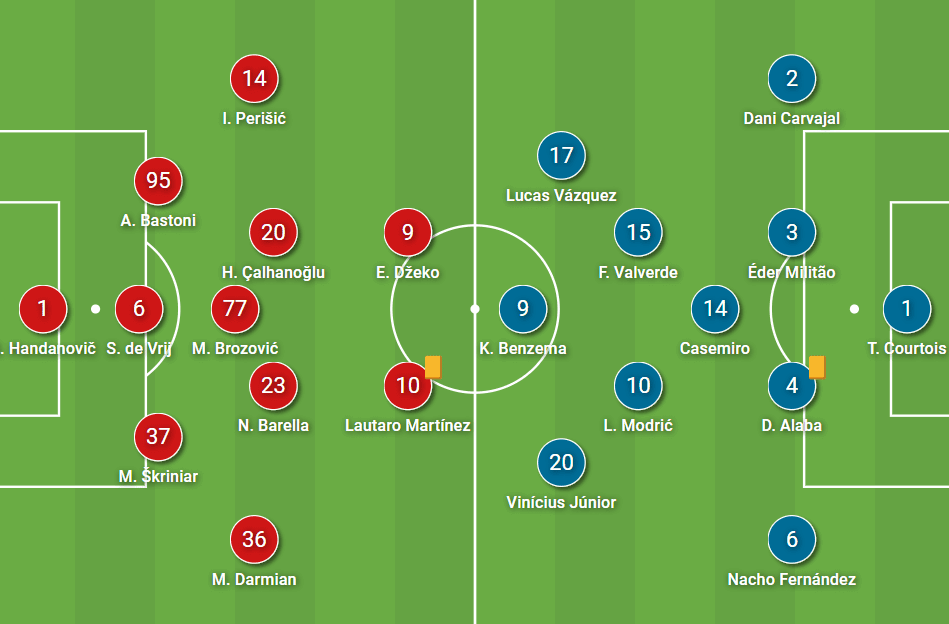
There were no real shocks when the team sheets were announced an hour before kick-off in terms of the personnel on the pitch or the chosen formation by both sets of coaches.
Inter lined up in their typical 3-5-2 as they have used for the past three seasons to major success. Veteran goalkeeper Samir Handanović started in goal for the home side and was protected by Inter’s usual back three which consists of Alessandro Bastoni as the left centre-back, Stefan de Vrij in the middle with Milan Škriniar on the right.
Former Manchester United defender Matteo Darmian was utilised as the right wingback with Ivan Perišić on the opposite flank. Marcelo Brozović was deployed in his number ‘6’ position and was supported by Hakan Çalhanoğlu and Nicolò Barella as the advanced ‘8s’. The experienced Edin Džeko partnered alongside Lautaro Martínez up top.
Carlo Ancelotti made some subtle changes, on his return to the San Siro, from the side that battered Celta Vigo 5-2 on Sunday, using a 4-3-3 which could easily transition into a 4-4-2 out of possession.
Courtois was guarding the net while Éder Militão and David Alaba were utilised as the central defenders with Nacho Fernández and Dani Carvajal as fullbacks.
Casemiro, Luka Modrić, and Federico Valverde began together in midfield – a trio with a plethora of quality and energy – and worked as the team’s core behind a three-man forward line of Vinícius Júnior and swiss army knife Lucas Vázquez as the wingers with Karim Benzema occupying the lone striker role as he does ever so well.
Inter playing down the right
Under Inzaghi, there is a much greater emphasis on taking risks by playing out from the back in contrast to Antonio Conte’s tenure. While Inter still built out from the goalkeeper under Conte, they also tended to go direct to the centre-forwards than under the current boss.
The Italian side did have less possession than their opponents on Wednesday, but the numbers were marginal. Inter tallied 48 percent of the ball compared to Real’s 52 percent.
When Inter had the ball in deeper areas of the pitch, they tried to play centrally through the three midfielders. The in-possession shape often resembled a 3-1-2-4/3-1-4-2 when the Nerazzurri had the ball in a structured attack and were trying to progress to the final third.
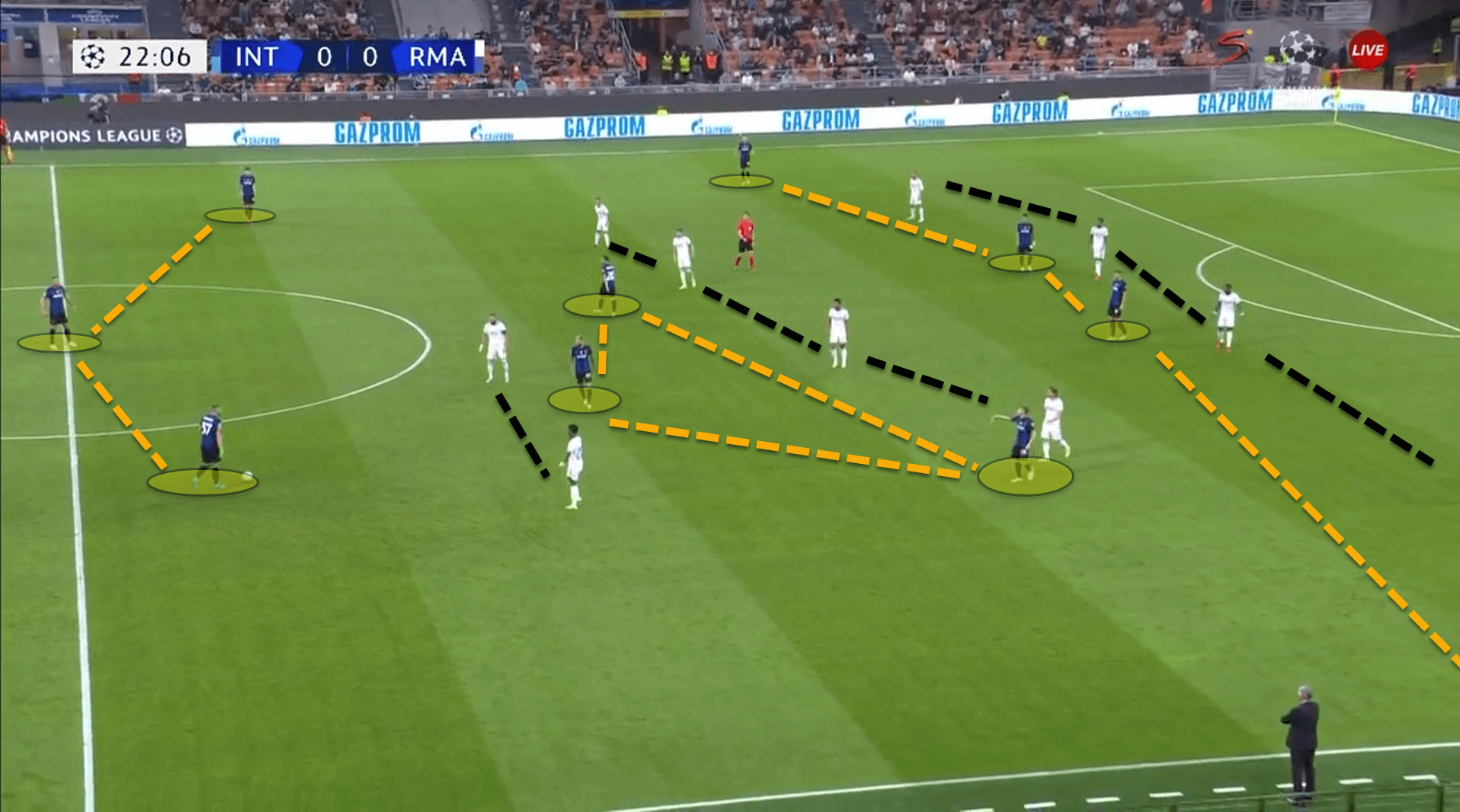
In contrast, Real’s base formation was a 4-3-3 but this switched to more of a 4-4-2 when they were forced to defend in a medium or low-level defensive block.
Real did not press too highly and ended the game with a Passes allowed Per Defensive Action (PDDA) of 13.29. The game-plan from Ancelotti was to prevent the three central midfielders from Inter from being able to turn on the ball on reception.
Generally, Valverde and Modrić would situationally play man-to-man against Calhanoglu and Barella while Casemiro would play zonally and pick up either of the two Inter centre-forwards if they dropped short to receive.
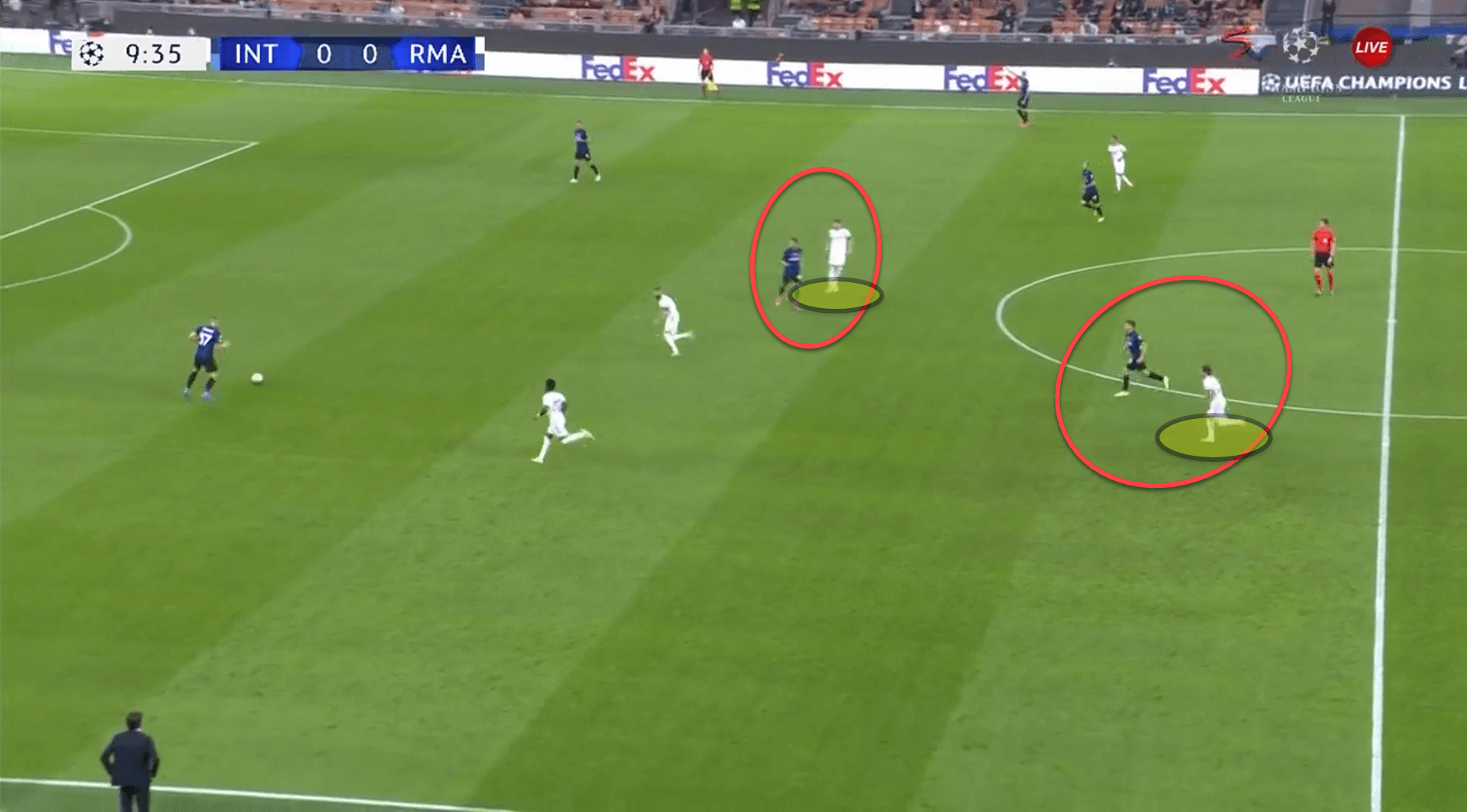
Due to the tight approach on their advanced midfielders, Inter were forced to go wide quite a lot but this was not too much of an issue for the home side as they possession immense quality on the flanks, including the two ‘8s’ who would push across to the wide areas, and they were also able to overload these parts of the pitch.
From 32 positional attacks by the home side, 24 were out on the flanks despite their most dangerous attacks coming from the central corridors. This was partly due to Los Blancos’ solid defensive low block.
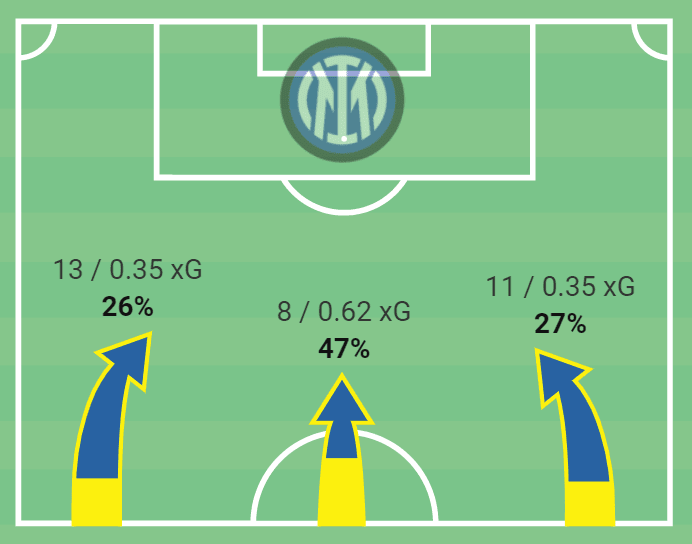
While Inter had more attacks down the left flank as both Çalhanoğlu and Perišić are very creative players, the Italians had more joy penetrating Real Madrid down the right flank.
Inter would often overload the right side by pushing Škriniar further forward to create numerical superiority on that flank with Brozović also dropping to help both Darmian and Barella.
Looking at Inter’s pass map for the game of their most progressive passes, this overload was the most successful way of progressing into the final third for Inzaghi’s side.
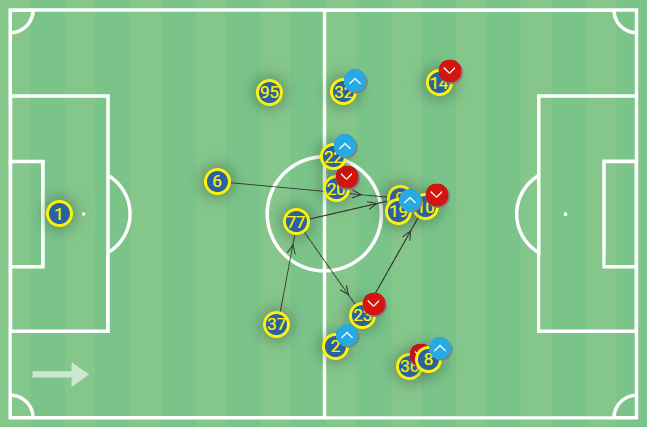
One noticeable detail of this map is how much higher and wider Škriniar is than both de Vrij and Bastoni. The Slovakian was tasked with push high to create the overload on the right side.
During these wide overloads, it allowed Barella to get free from Modrić. As Real Madrid defended in a 4-4-2 low block, Modrić pushed across as the auxiliary left-winger and marked Barella.
When the overloads occurred, Modrić would be forced to engage with another Inter player and so Barella was able to find space to receive the ball and either put crosses into the box or else play to the feet of the centre-forward. This was how Inter created a lot of solid opportunities, particularly in the first half.
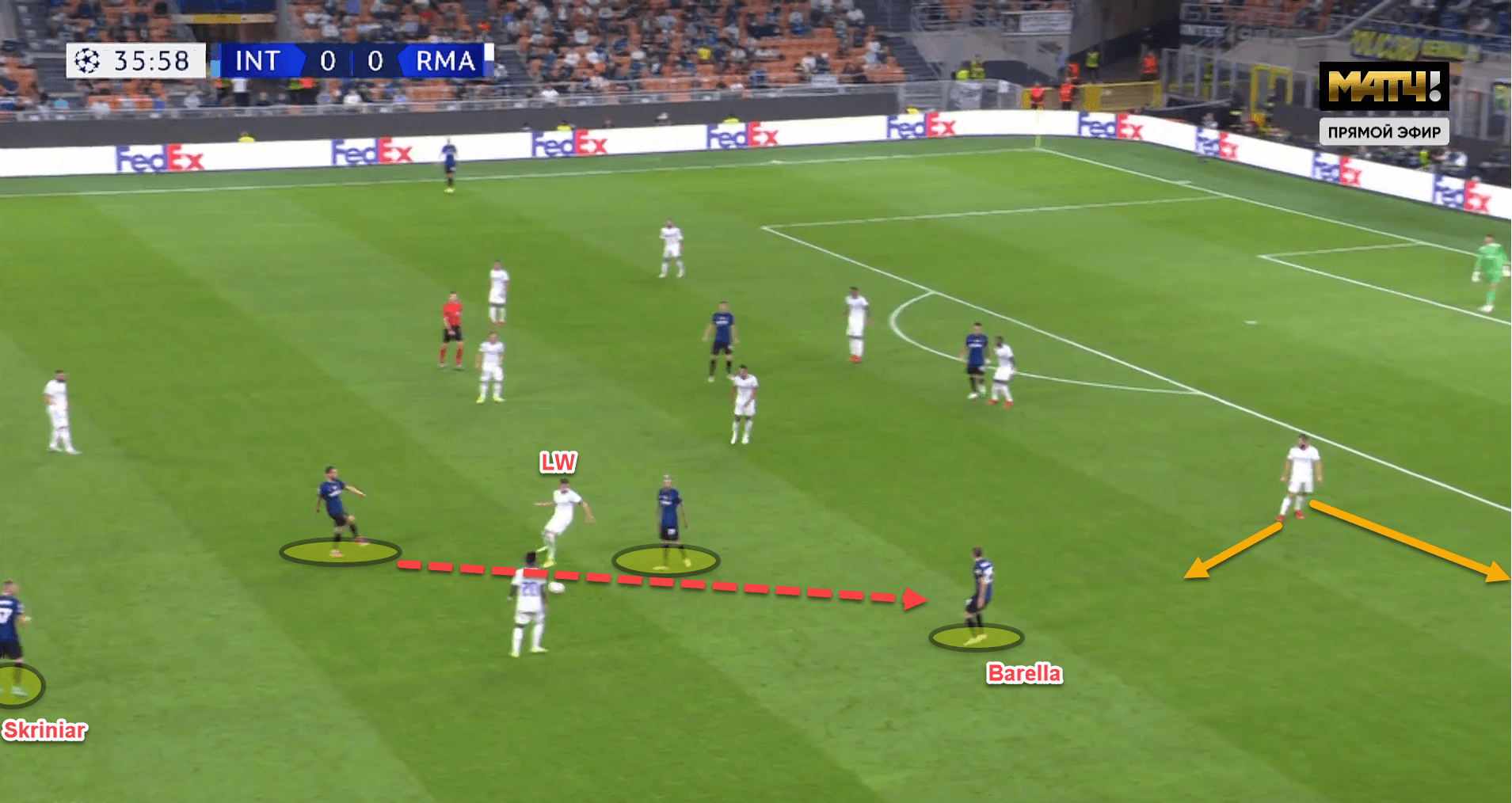
In this example, Modrić and Valverde have briefly swapped positions and so the latter is acting as the left of a four-man midfield. However, the point still remains. Valverde is occupied by Brozović and Çalhanoğlu drifting across to overload the right flank and so Barella can find himself free behind the opposition’s midfield line.
Real’s left-back Fernández is unable to push out to close the Italian midfielder down as then Darmian will be free on the right and so Barella gets time and space to put a cross into the box towards Džeko and Martínez.
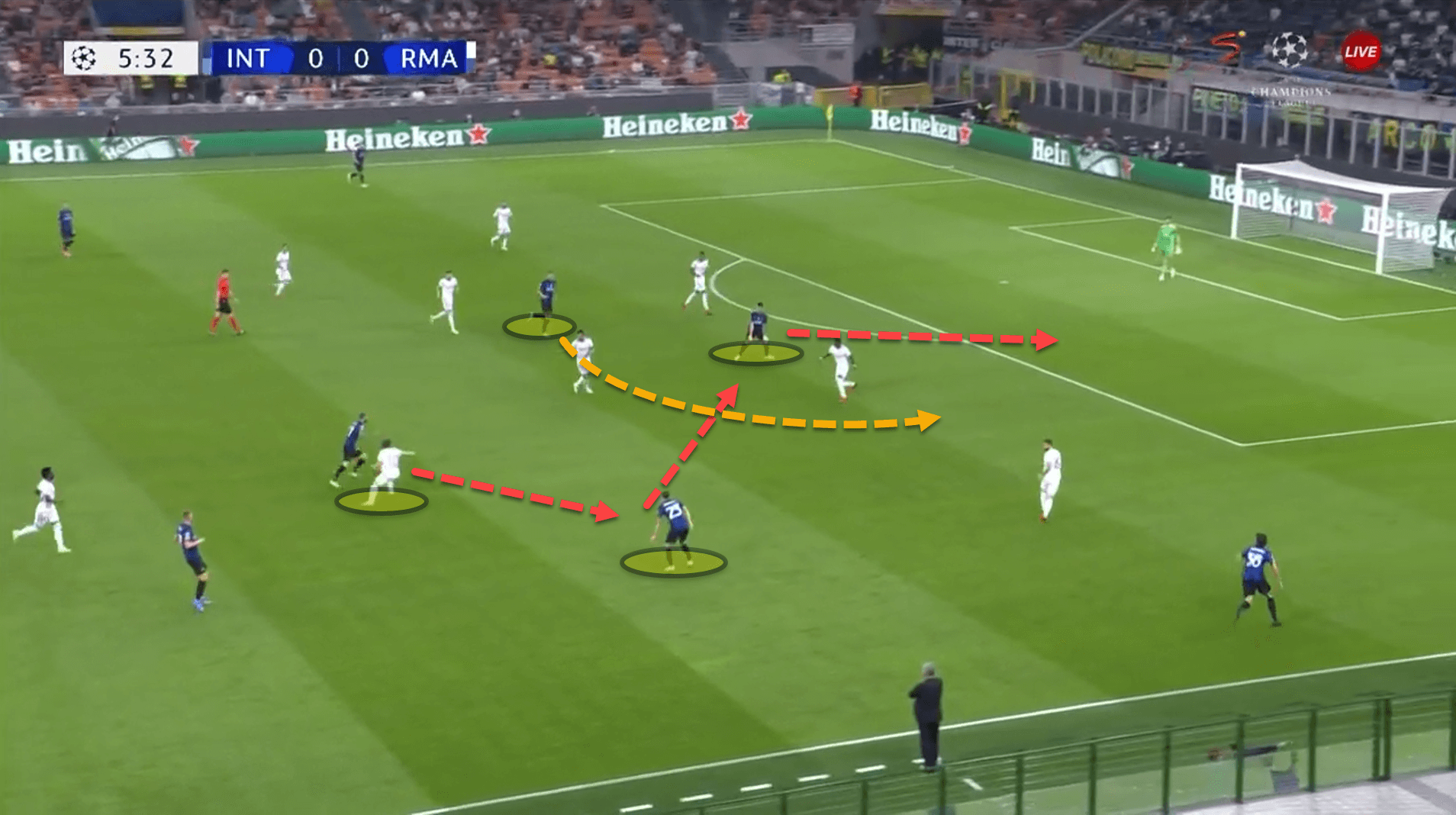
Inter created a wonderful chance in the sixth minute from a similar situation. Modrić was occupied and so Barella was able to get free in space. On reception of the ball, he slipped it into Martínez who used the excellent third-man run of Džeko to put the Bosnian international through on goal but Courtois made a really good save.
Solid defensive display from the Nerazzurri
Real Madrid’s shape when they had the ball in structured positional attacks was more of a 3-3-4 although it was mainly situational so pinpointing an exact shape is difficult.
One thing that was certain though was Ancelotti’s deployment of a back three. When the teamsheet was announced, it looked as though Alaba would play as the left-back but in reality, it was Fernández occupying this role.
The Spaniard would push inside when the visitors had possession while Carvajal bombed on and Vasquez drifted between the lines. As there was no left-back, Vinícius Jr was often tasked with hugging the touchline to hold the width and act as a wide passing option, but Modrić also dropped to the left flank quite a lot to stretch Inter who were extremely compact and defensively disciplined.
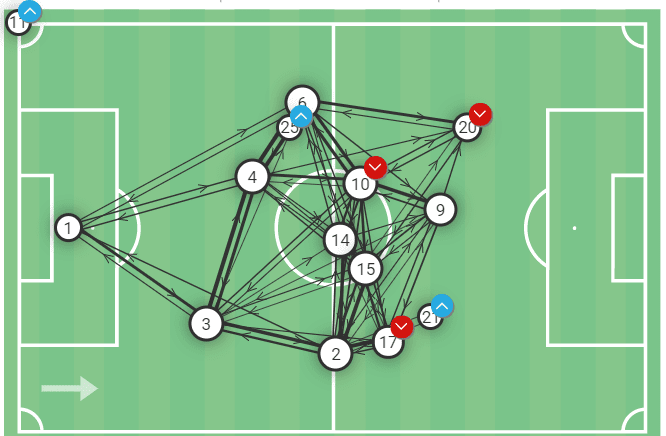
Here is Real’s pass map from the Champions League opener at the San Siro on Wednesday night. What is obvious from the pass map is the heavy focus put on circulating the ball with the back three and Carvajal and then playing inside to either Valverde or Modrić.
Real struggled to play to Casemiro for the most part because of the hard work from Inter’s first line of pressure and Brozović. When pressing high, Brozović would push up onto the Brazilian to mark him tightly while Barella and Çalhanoğlu would go man-to-man on Valverde and Modrić.
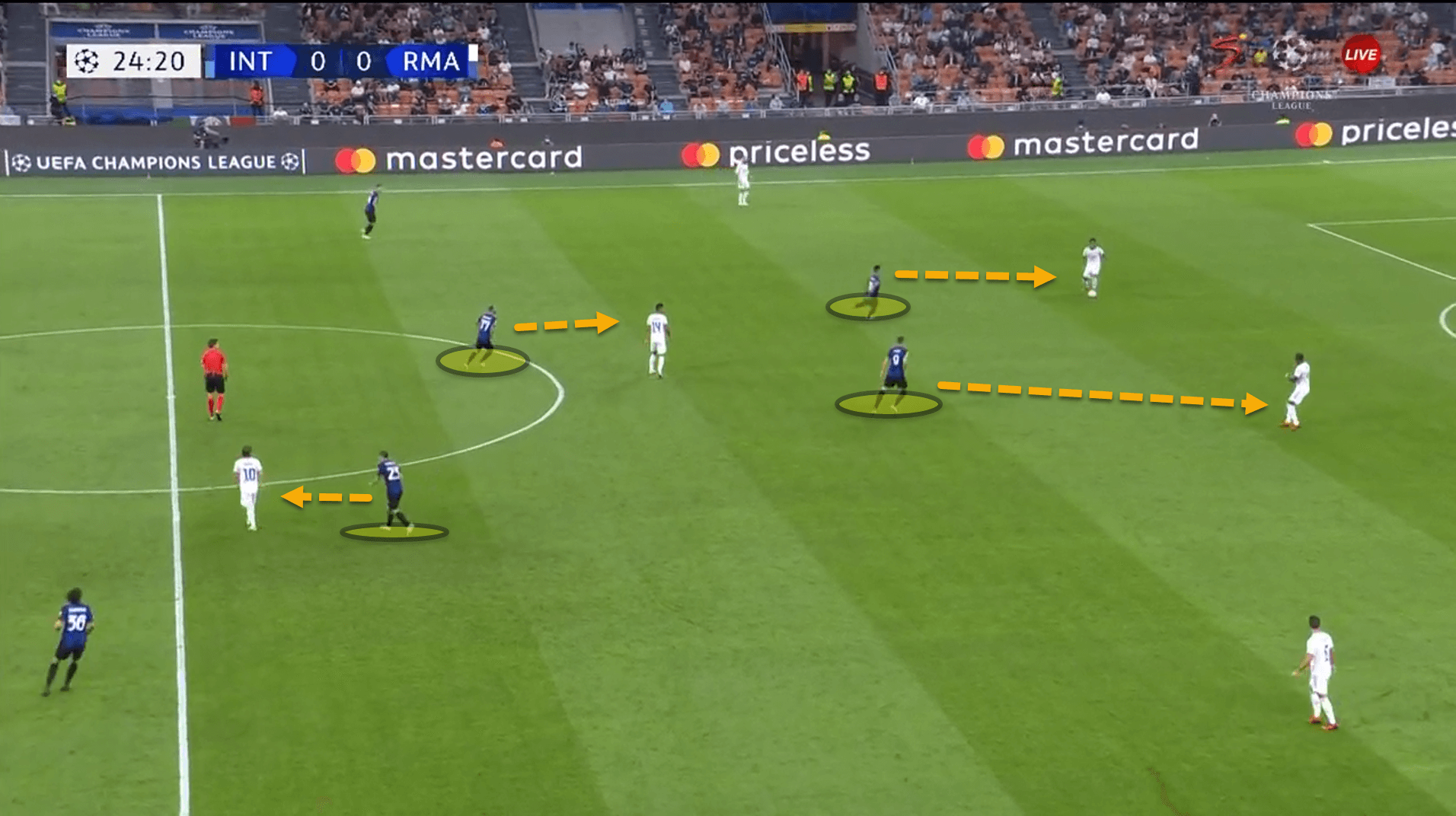
When Inter pressed high, the two centre-forwards would press the two centre-backs, but when the team dropped off to a medium block they were also tasked with marking Casemiro because Brozović had to drop off alongside the other two central midfielders.
Inter were fine with allowing Real’s first line to have possession of the ball and would apply very little pressure. Sometimes both of the centre-forwards would sit on Casemiro to prevent any ball supply into him but often one would press the centre-backs while the other would mark him.
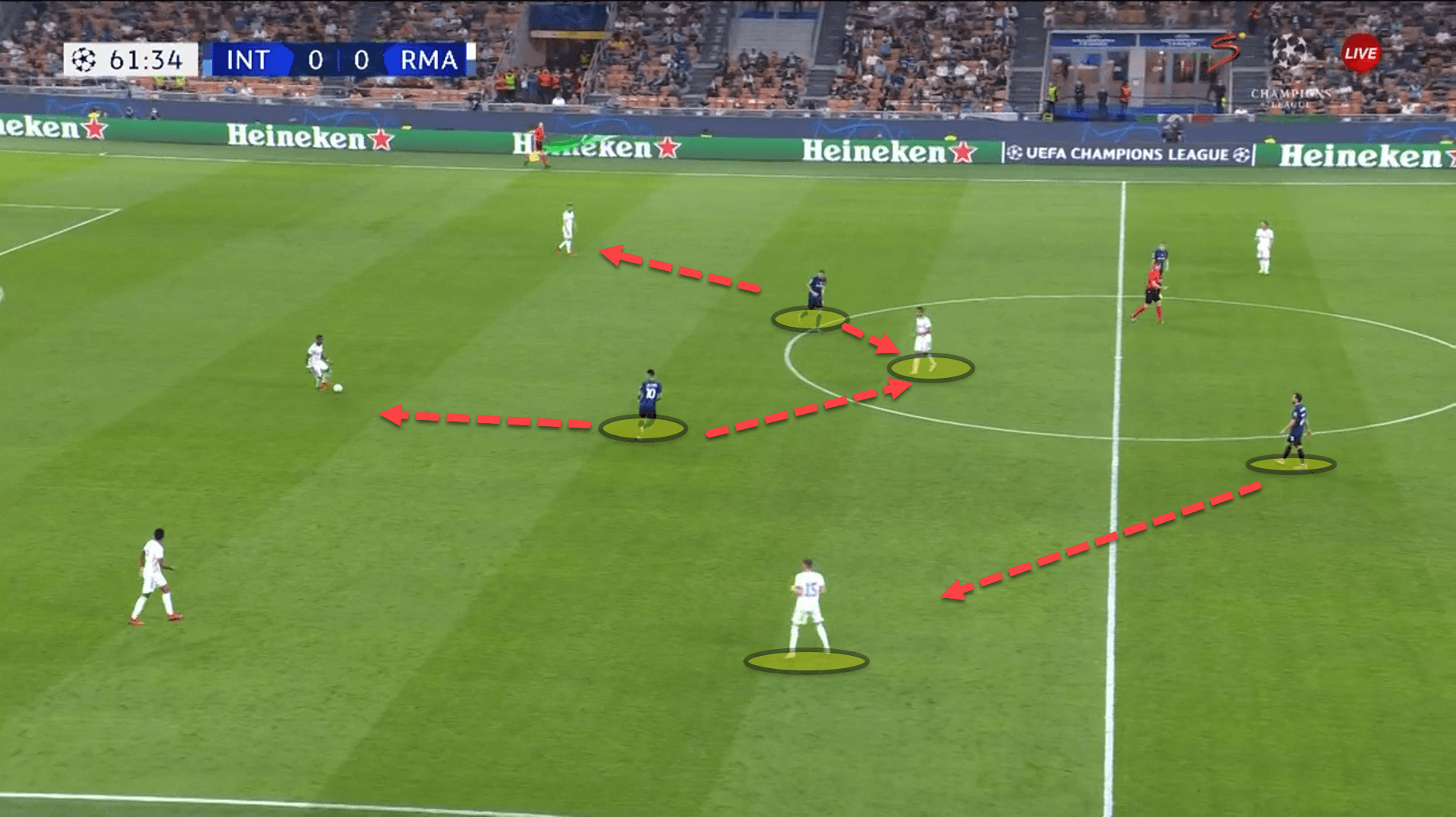
Real could not get the ball to him much and so were forced to go wide before playing back inside or else the two ‘8s’ would drop into the wide-area as Valverde has done in the above image. When this occurs, Inter’s ‘8s’ much push across to close them down.
If per se, Çalhanoğlu was forced to push wide to press Valverde who drifted wide, it was the duty of both Barella and Brozović to push across to cover the space while the defensive line would also shift over. Real would be forced to play backwards as there was no forward access.
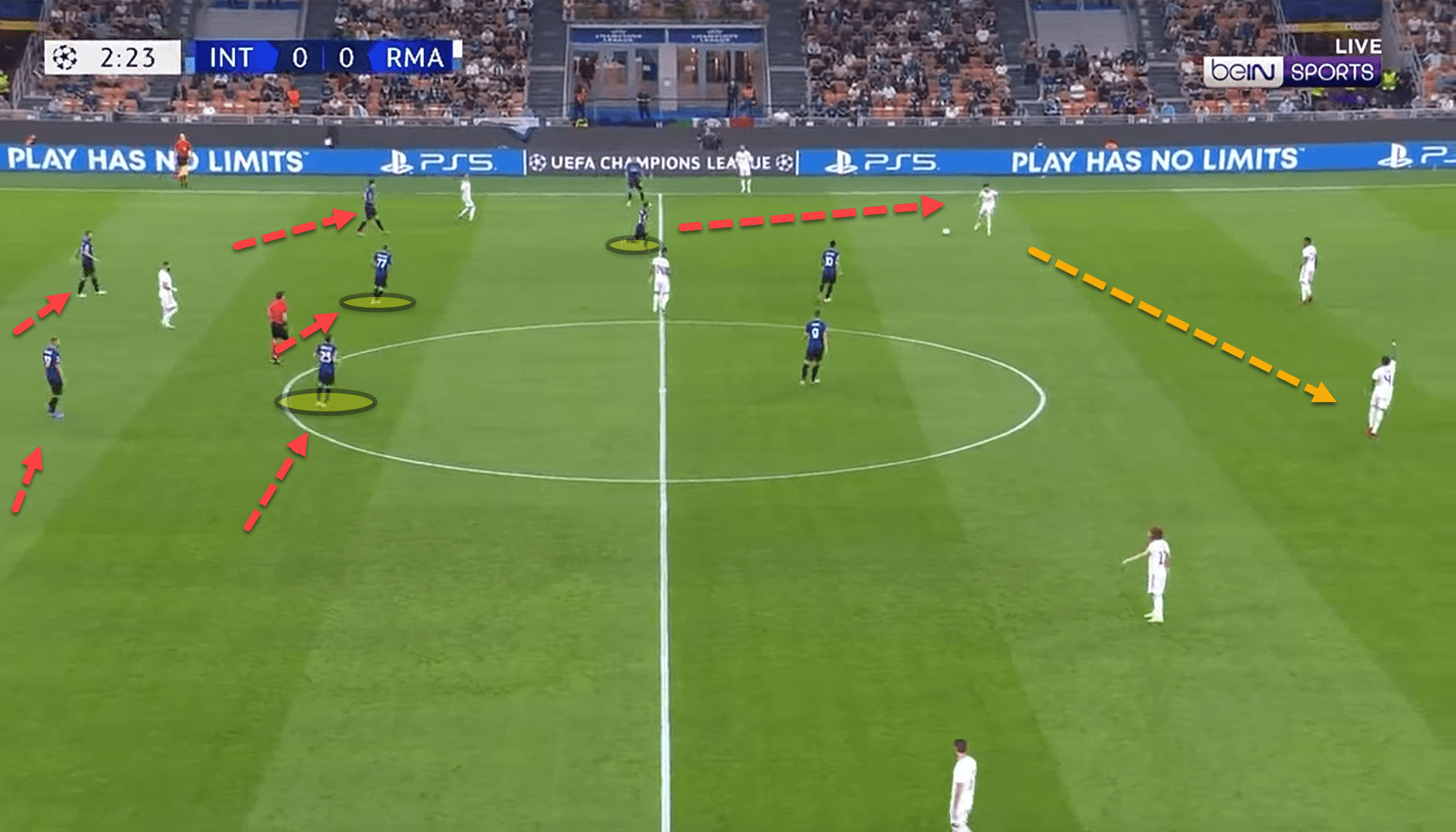
Inter worked in unison constantly and were really disciplined. Real struggled to reach any of their forwards between the lines and the majority of the possession was kept between the three central midfielders and backline.
The objective for Inter was to force Real into these areas where Inter could win the ball back. Looking at all of the team’s ball recoveries from the game, it is obvious where they tried to regain possession.
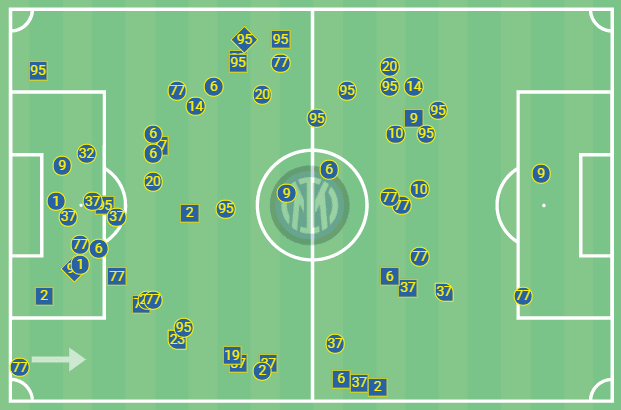
As can be seen from the data visual above, there are very ball recoveries in the middle of the park. The majority are out wide. Inter were trying to orient Real to play out wide by blocking off central access and then press from there.
Low block defending and match-winning goal
When the visitors did progress into more advanced areas of the pitch, Inter would drop off into a 5-3-2 low block, allowing for little to no space between the lines.
As Benzema does like to drop into this area to receive the ball to feet with his back turned to goal quite a lot, Inter’s central defenders had to be really aggressive in closing him down. In fact, Inter’s centre-backs were tasked with closing down any player that was looking to receive the ball or had received the ball between the lines.
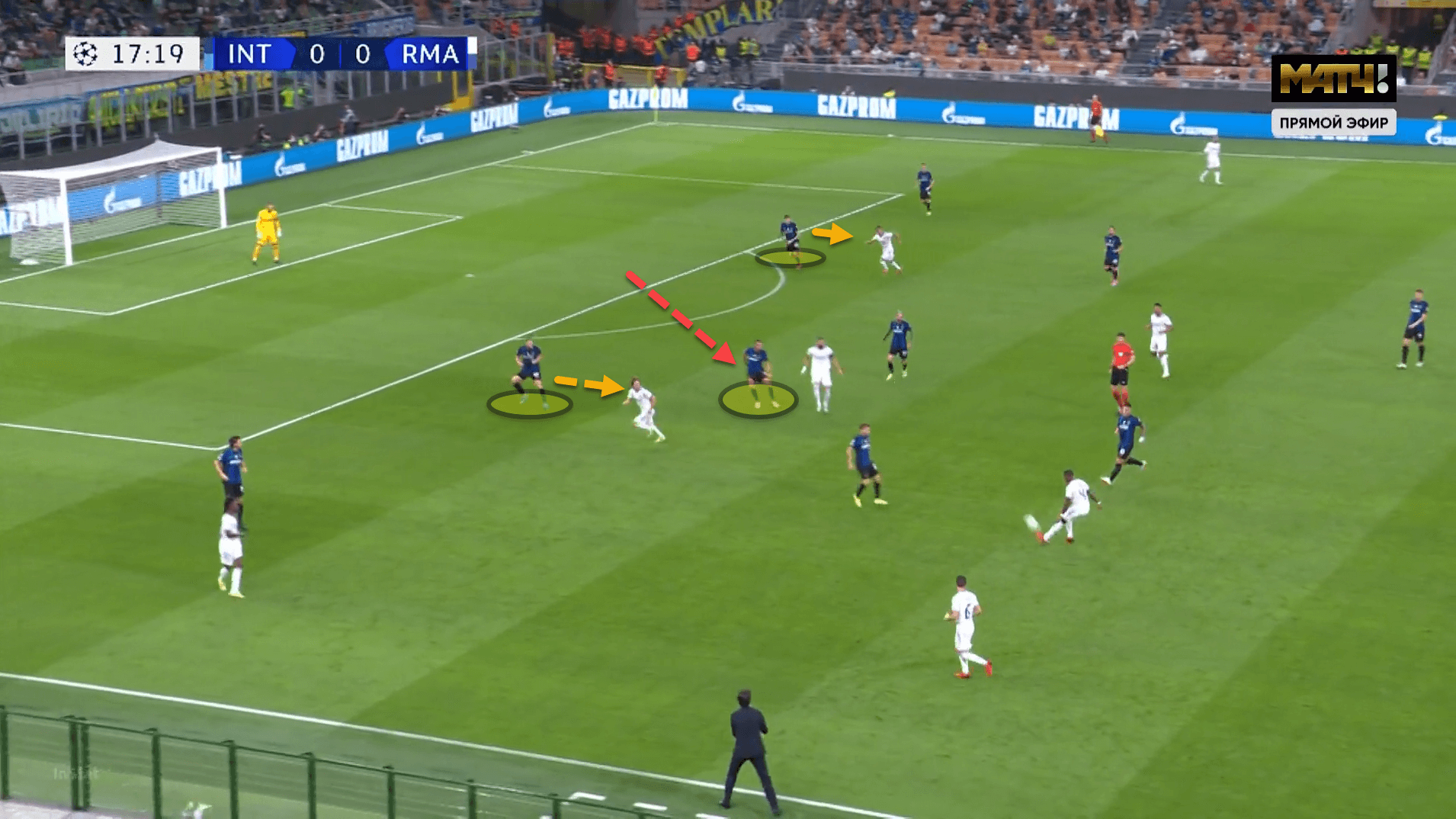
Again, Inter were extremely disciplined in their defensive approach in all thirds of the field which is a credit to the wonderful game-plan by Inzaghi out of possession.
Unfortunately, for the Italian champions, this fell apart in the 90th minute when a wonderful, chipped ball from Valverde to Eduardo Camavinga eventually found its way to Rodrygo who struck home to take all three points. But how did the goal come about?
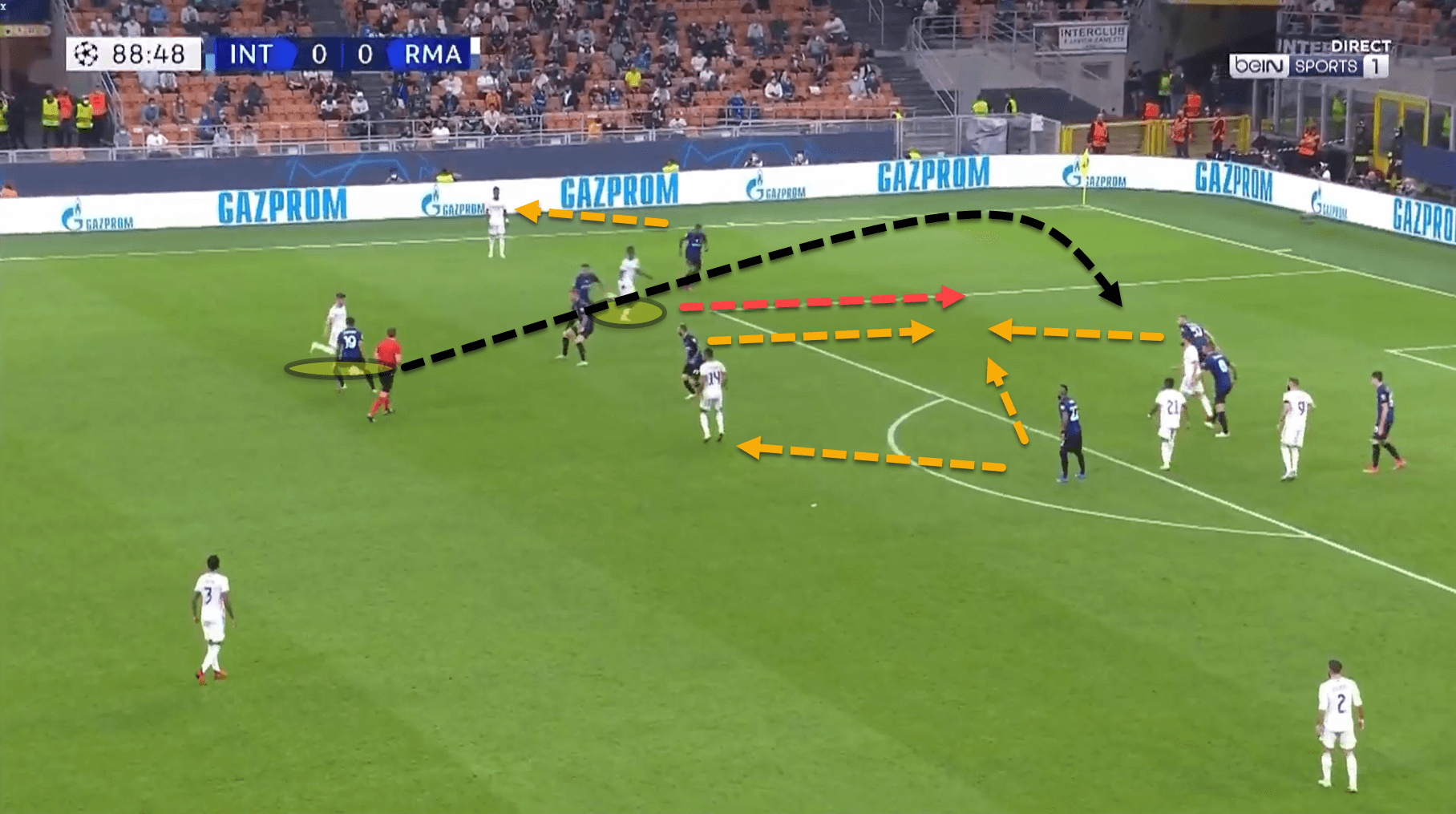
Valverde chipped the ball into Camavinga who was running into a massive space between Inter’s right wingback and right centre-back. No player managed to cover the space despite there being at least four players nearby.
The ball found its way to Camavinga who cushioned it for Rodrygo, and the Brazilian scored past the experienced Handanović. Bastoni failed to get close enough to block the shot by Rodrygo and the strike was out of reach of the keeper.
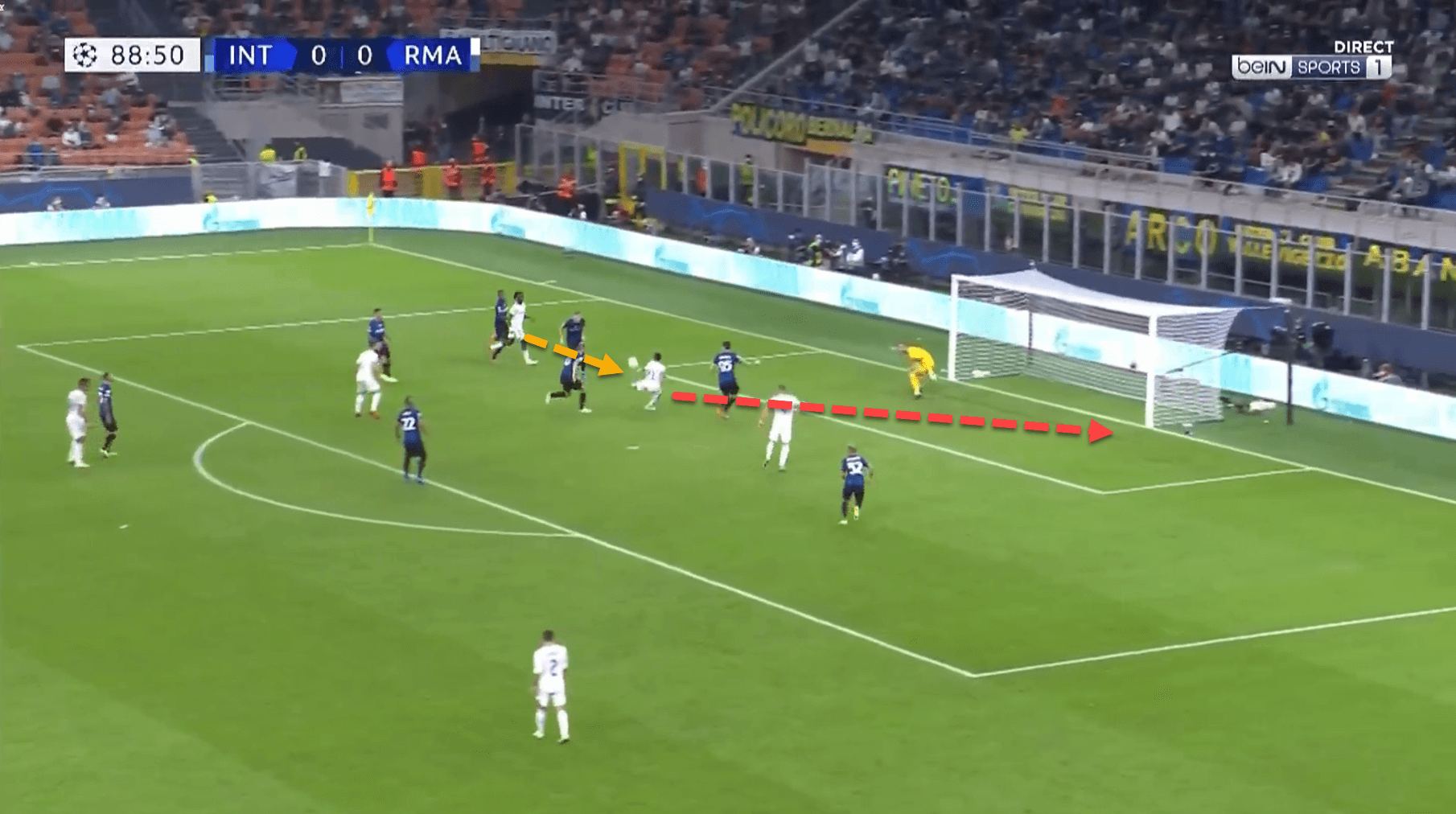
Conclusion
Football can be a game of extremely fine margins. Inter defended incredibly well throughout the game but Real Madrid refused to stop knocking at the door. There is no guarantee, but sometimes if you keep knocking on the door you will eventually get an answer.
Inzaghi will be extremely disappointed by the result but not the performance. Inter boasted an xG of 2.09 compared to Real’s 1.36 so the final score could have easily been a lot different. Thankfully for the Nerazzurri, they will be able to get their revenge on 6 December when they make the trip to Spain for the final group game.






Comments